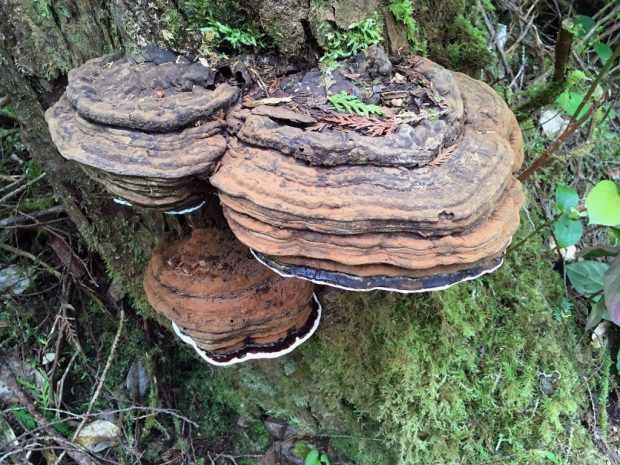Conks are also called shelf fungi or bracket fungi. They belong to the kingdom “Fungi,” which incorporates different mushrooms, fungi, and yeast. Conks are the spore-producing fruiting structures of a fungus. They are seen growing on tree trunks and branches, ends, and fallen tree logs.
Fungus is composed of the mycelium, which is the central part of the fungus body. It also consists of long thin fiber-like filaments that seep and dwell in the wood of a tree. The mycelia feed on the wood. They secrete certain enzymes that break down cellulose or lignin and cause wood rot. However, some fungi protect the tree on which they dwell from more malignant fungi. Fungi are an integral part of the ecosystem. They aid in the decomposition of wood material, hence act as important recycling agents for the forest. During processing, woody fungi break down nutrients, strengthen the soil and build suitable homes for birds, woody mammals, and insects.
Conk Mushroom Identification
The cap surface of the conk tram is “uneven,” furrowed, rough, and covered with a rust-colored shell, so it is effortless to find it. The edge is white or in cream color.
The white pore surface is scuffed when touched, making it difficult to use for artwork. The flesh is brown to rusty brown, which is very tough. The size of the conk cap is from 5 to 75 cm wide.
Height of Conk
It has little or no height since it is a bracket fungus. Some fungal species have short stature, but they are scarce.
Habitat of Conk
Conks are primarily seen in forests on the trees, mainly on trunks, branches, and fallen wooden logs. They may appear singly or in groups. They are mostly found all over Canada and the United States. They are also found in areas of Europe, Asia, and Australia.
Colour of Conk
The shells of the conks are usually woody brown or rust-brown, whereas the edges are either pure white or creamy-white.
Growing Season of Conk
Conks are constantly growing; each year, new growths lead to new trenches on the surface. That is why there is no specific growing season.
Conk Mushroom Uses
Conk Mushrooms are medicinal-grade fungi that are widely used in making a tincture. They are also used in Asian Cuisines, as a flour enhancer, because they have rich mushroom flavor.
It is advised not to eat them in raw form because they are harsh and non-digestible if not cooked properly. Conk Mushrooms are also widely used in smoothies after being finely chopped, dried, and ground in fine powder. They are also used in herbal soups and as a flavor enhancer in fermented foods. They have a very refreshing scent.
They also serve as a drawing medium for artists. When the fresh white surface of the fungus is scratched with a sharp object, the dark brown tissue appears under the pores, resulting in visible lines and shadows that become permanent after the fungus has dried.
Conk Mushroom Types
There are many types of Conk Mushrooms. Some are collected for their medicinal property while others are used for decorative and artistic purposes. Some of them are found very rarely while others are found in abundance.
1. Tinder Conk
2. Quinine Conk
3. Artist’s Conk
4. Chaga/ Clinker Conk
5. False Tinder Conk
Let’s talk about some of the species found in Alaska.
- Tinder Conk
It is also called Hoof Fungus because it appears as a hoof and has a smooth surface. It is commonly found in the boreal forests of the northern region of Alaska. It is grey to black with horizontal patterns across the cap. Its size reaches up to 6 inches when fully matured.
- Quinine Conk
Quinine Conk is also called Agarikon. It is also a hoof-shaped conk like a Tinder conk. As it grows, It becomes cylindrical and elongates with age. It is also called brown Trunk Rot. It is a very rare type of Conk and can be found in the southeastern areas of Alaska. It has a very bitter taste.
- False Tinder Conk
False Tinder Conk resembles a lot with the Tinder Conk as it is also a shelf-fungi and is hoof-shaped. It also grows on the Trunks of the trees in forests. It is very difficult to differentiate between the Tinder Conk and False Tinder Conk. However, the main differentiation between the two is that Tinder Conk has a lighter underside while False Tinder Conk has a darker underside.



